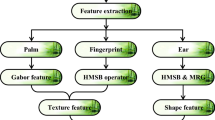Abstract
In the real world applications, wireless networks are an integral part of day-to-day life for many people, with businesses and home users relying on them for connectivity and communication. This paper examines the problems relating to the topic of wireless security and the background literature. The biometric systems often face limitations because of sensitivity to noise, intra class invariability, data quality, and other factors. Improving the performance of individual matchers in the aforementioned situation may not be effective. Multi biometric systems are used to overcome this problem by providing multiple pieces of evidence of the same identity. This system provides effective fusion scheme that combines information presented by the multiple domain experts based on the Rank level fusion integration method, thereby increasing the efficiency of the system which is not possible by the unimodal biometric system. The proposed multimodal biometric system has a number of unique qualities, starting from utilizing principal component analysis and fisher’s linear discriminant methods for individual matchers authentication and the novel rank level fusion method is used in order to consolidate the results obtained from different biometric matchers. The ranks of the individual matchers are combined using highest rank, Borda count, and logistic regression method. From the results it can be concluded that the overall performances of the wireless security based multi biometric systems are improved even in the presence of quality of data.









Similar content being viewed by others
References
Monwar, M. M., & Gavrilova, M. L. (2009). Multimodal biometric system using Rank Level Fusion approach. IEEE Transactions on System, Man and Cybernetics – Part B: Cybernetics, 39(4), 67–73.
Chang, K., Bower, K. W., Sarkar, S., & Victor, B. (2003). Comparison and combination of ear and face images in appearance-based biometrics. IEEE Transactions Pattern Analysis and Machine Intelligence, 25(9), 1160–1165.
Snelick, R., Uludag, U., Mink, A., Indovina, M., & Jain, A. (2005). Large-scale evaluation of multimodal biometric authentication using state-of-the-art systems. IEEE Transactions on Pattern Analysis and Machine Intelligence, 27(3), 450–455.
Toh, K. A., Jiang, X. D., & Yau, W. Y. (2004). Exploiting global and local decisions for multi-modal biometrics verification. IEEE Transaction on Signal Processing, 52(10), 3059–3072.
Ross, A., Nandakumar, K., & Jain, A. K. (2006). Handbook of multibiometrics. New York: Springer.
Hong, L., & Jain, A. K. (1998). Integrating faces and fingerprints for personal identification. IEEE Transaction on Pattern Analysis Machine Intelligence, 20(12), 1295–1307.
Marcialis, L., & Roli, F. (2004). Fingerprint verification by fusion of optical and capacitive sensors. Pattern Recognition Letters, 25(11), 1315–1322.
Frischholz, R., & Dieckmann, U. (2000). BiolD: A multimodal biometric identification system. Computer Science Journal, 33(2), 64–68.
Kumar, A., & Zhang, D. (2004). Palm print authentication using multiple classifiers. In Proceedings SPIE conference, biometric technology human identification, Orlando (pp. 20–29).
Heseltine, T., Pears, N., Austin, J., & Chen, Z.(2003). Face recognition: A comparison of appearance-based approaches. In Proceedings 7th digital image computing: Techniques and applications, Sydey, Australia (pp. 59–68).
Rodrigues, R. N., Ling, L. L., & Govindaraju, V. (2009). Robustness of multi-modal biometric fusion methods against spoof attacks. Journal of Visual Language and Computing, 20, 169–179.
Akhtar, Z. (2012). Security of multimodal biometric systems against spoof attacks. Ph.D. Thesis, University of Cagliari, Italy.
Akhtar, Z., & Alfarid, N. (2011). Secure learning algorithm for multimodal biometric systems against spoof attacks. In International conference on information and network technology (ICINT) (pp. 52–57).
Rahman, M. M., & Ishikawa, S. (2004). A robust recognition method for partially occluded/destroyed objects. In Proceedings 6th Asian conference on computer vision, Jeju, Korea (pp. 984–988).
Fierrez-Aguilar, J., Ortega-Garcia, J., Garcia-Romero, D., & Gonzalez- Rodriguez, J. (2003). A comparative evaluation of fusion strategies for multimodal biometric verification. In Proceedings of 4th international conference on audio–video-based biometric person authentication (Vol. LNCS 2688, pp. 830–837).
Wang, T., Tan, T., & Jain, A. K. (2003). Combining face and iris biometrics for identity verification. In Proceedings 4th international conference on audio–video-based biometric person authentication (Vol. LNCS 2688, pp. 805–813).
Ross, A., & Jain, A. K. (2003). Information fusion in biometrics. Pattern Recognition Letters, 24(13), 2115–2125.
Snelick, R., Uludag, U., Mink, A., Indovina, M., & Jain, A. K. (2005). Large scale evaluation of multimodal biometric authentication using state-of the-art systems. IEEE Transaction Pattern Analysis and Machine Intelligence, 27(3), 450–455.
Erp, M. V., & Schomaker, L. (2000). Variants of the Borda count method for combining ranked classifier hypotheses. In Proceedings 7th international workshop frontiers handwriting recognition, Amsterdam, The Netherlands (pp. 443–452).
Kinnunen, T., Hautamäki, V., & Fränti, P. (2004). Fusion of spectral feature sets for accurate speaker identification. In Proceedings 9th conference speech and computer, St. Petersburg, Russia (pp. 361–365).
Bhatnagar, J., Kumar, A., & Saggar, N. (2007). A novel approach to improve biometric recognition using rank level fusion. In Proceedings IEEE conference computing visual pattern recognition (pp. 1–6).
Marcialis, G. L., & Roli, F. (2004). Fusion of appearance-based face recognition algorithms. Pattern Analysis Application, 7(2), 151–163.
Down, M. P., & Sands, R. J. (2004). Biometrics: An overview of the technology, challenges and control considerations. Information System Control Journal, 4, 53–56.
Author information
Authors and Affiliations
Corresponding author
Rights and permissions
About this article
Cite this article
Mary Praveena, S., Vennila, I. An Effective Security Based Wireless Information System Based on Fusion Principal Component Analysis. Wireless Pers Commun 86, 887–899 (2016). https://doi.org/10.1007/s11277-015-2960-7
Published:
Issue Date:
DOI: https://doi.org/10.1007/s11277-015-2960-7




